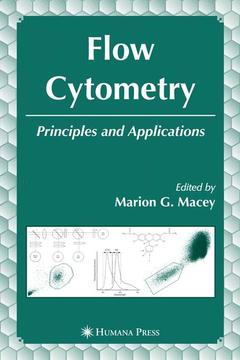1 Principles of flow cytometry Marion G Macey 1.1 History and development of flow cytometry 1.2 Principles of flow cytometry 1.3 Fluorescence analysis 1.4 Light scatter and fluorescence detection 1.5 Acquisition 1.6 Amplification 1.7 Histograms 1.8 Coefficients of variation CV's 1.9 Spectral overlap and compensation 1.10 Safety aspects of lasers 1.11 Cell sorting 1.12 Commercial flow cytometers 1.13 References 2 Cell preparation Desmond A. McCarthy 2.1. Introduction 2.2. Factors affecting the choice of prepation procedure: live versus fixed samples 2.3. Factors affecting cell preparation 2.3.1. Processing blood and bone marrow samples 2.3.1.1. Live whole blood procedures 2.3.1.2. Leucocyte isolation techniques (Dextran sedimentation, Density gradient centrifugation, Immunoselection, Erythrocyte lysis) 2.3.1.3. Lysed whole blood procedures 2.3.2. Preparation of cell suspensions from organs, tissues and cell cultures 2.4 Fixation: commonly used fixatives and their effects 2.5. Permeabilisation and the detection of intracellular components 2.6. Immunolabelling 2.6.1. Antibodies 2.6.2. Antibody-antigen interactions 2.6.3. Antibody titration 2.6.4. Sensitivity of detection and the measurement of cell surface antigens 2.6.5. Direct and indirect immunostaining 2.6.6. Determining absolute cell counts 2.7. Safety 2.8. References 3 Fluorochromes and fluorescence Desmond A. McCarthy 3.1. Introduction 3.2. Interactions between light and matter 3.3. Light absorption leading to fluorescence 3.4. Mechanisms of fluorescent staining 3.5. Cellular autofluorescence 3.6. Fluorescence resonance energy transfer (FRET) 3.7. Fluorochromes for labelling antibodies, proteins and ligands 3.7.1. Fluorescein and other green fluorescent fluorochromes 3.7.2. Phycobiliproteins (phycoerythrin, allophycocyanin and CryptoFluor' dyes) and peridinin-chlorophyll a complex (PerCP) 3.7.3 Tandem dyes 3.7.4. Quantum dots 3.7.5. Conjugation of fluorochromes to antibodies, proteins or small ligands 3.7.6. Indirect immunolabelling with fluorochromes conjugated to protein A or G, avidin or streptavidin 3.8. Fluorochromes for labelling nucleic acids 3.9. Fluorescent probes for cell viability and apoptosis 3.9.1 Membrane integrity 3.9.2. Transmembrane potential 3.9.3 Apoptosis 3.10. Fluorescent probes for determining intracellular ion concentrations 3.10.1. Calcium ions 3.10.2. pH values 3.11. Fluorescent probes for phagocytosis and oxidative metabolism 3.11.1. Phagocytosis 3.11.2. Oxidative metabolism 3.12. Fluorochrome-labelled substrate analogues for measuring enzyme activity 3.13. Fluorescent dyes for measuring total protein 3.14. Fluorochromes combinations suitable for use in instruments equipped with a single laser emitting at 488 nm 3.15. Fluorochrome options when using instruments equipped with light sources additional to a 488 nm laser 3.16. References. 4 Quality control in flow cytometry David Barnett and John T Reilly 4.1 Introduction 4.2 Internal Quality Assurance 4.3 Instrument Quality Control 4.3 Quality control issues and pitfalls 4.4 External Quality Assessment 4.5 Reagent selection 4.6 Definition of Positive Values 4.7 Absolute Count Enumeration 4.8 Conclusion 4.9 References. 5 Experimental design, data analysis and fluorescence quantitation. Mark Lowdell 5.1 Introduction 5.2 How many events should be acquired? 5.3 The use of 'thresholding' to enhance data acquisition rates. 5.4 The choice of fluorochrome. 5.6 The choice of monoclonal antibody clone (mAb) clone. 5.7 The choice o




